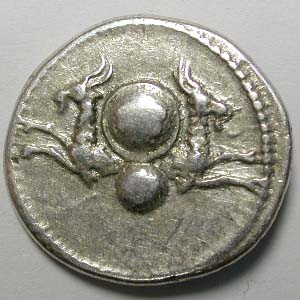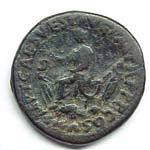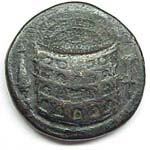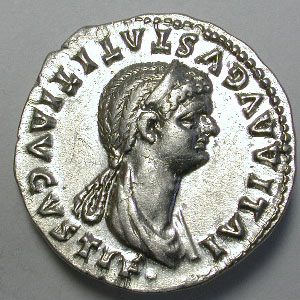

Coinage
In his portraits, Titus could be described as a younger version of his father. He had the typical Flavian broad face and forehead, closely set eyes with arched eyebrows and a hooked nose. His hair is fuller and curlier than Vespasianís and his lips are not quite as thin. His is usually shown on his coin portraits with a short stubby beard covering his neck. In contrast to Suetoniusí description of a muscular and graceful youth, the coin portraits of the mature Titus show him to be fat, presumably from the extravagant banquets held when he was Caesar (Titus 7.1). His portrait is usually compact but detailed, except on bronze coins where a massive portrait dominates the coin. Titusís gold and silver coins were produced regularly until July 80 when the fire occurred in Rome. The mint of that time may have been established at the temple of Juno Moneta on the Capitoline hill; an area devastated by fire.
As would be expected, Titusís initial issues were carried over from Vespasian and, naturally, the seminal event in Flavian coinage, the Judea Capta series, continues under the victor of Jerusalem. The familiar Jewess seated under a palm tree type was repeated (RIC 91-93). In 80, a reverse type of two captives seated on the ground with a trophy probably representing a victory in Britain (RIC 21a-b).
Titusís ascension was portrayed on coins stressing his peaceful assumption of power. One sestertius reverse portrays Vespasian presenting the regimen orbis, symbolized by a globe over a rudder, to Titus (RIC 97, 98). Another portrays Titus on horseback receiving the palladium from Roma (RIC 104). This type recalls an earlier sestertius struck by Vespasian showing the emperor extending his hand to raise up a kneeling Roma (RIC 445 ff.). The concord between Titus and Domitian is celebrated by another sestertius type depicting the brothers, togate, clasping hands with the legends PAX AUGUSTI and PIETAS AUGUST (RIC 95, 96). Also, the reverse type depicting Spes could be taken to apply to Domitian as heir-apparent (RIC 80).




Vespasianís deification in 80 was marked by the issuing of coins in gold, silver and bronze. A reverse type of a Victory with trophy (RIC 59) recalls the Jewish war. A reverse depicting a shield supported by two capricorns (RIC 63) seems to be borrowed from a sestertius honoring Divus Augustus; another reverse shows the sacred carriage of Divus Vespasian (RIC 60). One of the more elaborate types, appearing on a sestertius, depicts Vespasian seated on a funeral carriage drawn by four elephants, each driven by a mahout (RIC 143). Coins issued for Diva Domitilla include a series of rare denarii with her portrait and two commemorative sestertii depicting a carpentum drawn by two mules (RIC 153, 154).
A significant set of coins was issued in 80 in conjunction with the divine propriation of the gods for the plague and fire in Rome and the eruption of Vesuvius (RIC 23a ff.). The coins refer to the sellisternium, a banquet that was laid out in the forum to placate the gods, with the emperor and leading citizens as suppliants. Such rites required that the sacred couches of the gods, or pulvinaria, be set out with emblems of the deity placed on the couch instead of an image. There are several such representations on the coins of Titus and Domitian: a winged thunderbolt on a draped couch (Jupiter), a dolphin on an anchor (Neptune), a tripod on which are a wreath and dolphin (Apollo), a helmet on a draped couch (Minerva), a lighted altar (Vesta), ears of wheat on a throne (Ceres) and curule chairs surmounted by a wreath.
Two symbols that require explanation are a triangular object and a semi-circular object. These symbols are intended to be struppi -- a wreath or garland or even a bunch of foliage, intended to represent the head of the god. The triangular object appears on sacred carriages of a divus, for example those of Divus Claudius and Divus Vespasian (RIC 60). It has been identified as derived from the fastigium imperatoris, granted to Caesar and subsequent emperors to adorn their dwellings (Claudius 17). The semi-circular object appears on the sacred carriage (or carpentum) of the divae as a canopy. This form became associated with the empress, as is clear from coins depicting the temple of Diva Faustina struck by Antoninus Pius where the semi-circle appears on the steps of the temple. The propriation series was issued at about the same time as the coins of Divus Vespasian and Diva Domitilla, so it is apparent that these symbols are intended to represent the new deities.[1]
A very rare sestertius commemorates the dedication of the Colosseum in 80.
When Julia was given the title Augusta, undated denarii and
dupondii were issued in her name by Titus. The reverse types, in both metals, associate
her with Venus, Ceres and Vesta. Her denarii portraits (RIC 54-64) show Julia wearing a
diadem; the first living woman to be so depicted. The portraits of her dupondii (RIC
177-180) are similar to the bust of Julia in the Museo Nazionale delle Terme in Rome. Her
hair is a mass of curls, arranged around her forehead. The rest of her hair is braided and
fastened in a bun on the back of her head. An important feature of Titusís coinage are the restorations issued
to honor his Julio-Claudian predecessors. This was the first time that a commemorative
series had been issued. The coins were struck in base metals giving them a wider
circulation than gold and silver and honored: Augustus, Livia, Agrippa, Tiberius, Drusus,
Nero Claudius Drusus, Germanicus, Agrippina the Elder, Claudius and Galba (RIC 184-249).
They were reproduced precisely from the originals bearing Titusís titles on the
reverse in place of the usual legend. Not only did Titus succeed in creating a reminder of
Flavian links to the Julio-Claudians but gave these early imperial coins new life. The
medallic sestertius of Britannicus, sometimes attributed to Titus, was instead issued
during the reign of Claudius at a provincial mint. This series of coins honored Agrippina,
Nero and Britannicus. † Conclusion Was Titus the darling of the human race? The words used by Suetonius are
an exaggeration of Titusís personality. He was endowed with considerable charm,
talent and intelligence. His version of a benevolent, paternalistic autocracy succeeded
during the short term of his reign. Had Titus been granted a longer reign his celebrated
clemency probably would have been challenged and he would have to exert increasing
authority. Domitianís reign began much like that of Titus with the exercise of
clemency but, after a few years, Domitian gradually turned toward open autocracy. The
character of Titusís reign remains an enigma, and the catastrophes that occurred have
lent him a certain amount of sympathetic concern. Typically, the ancients tended to categorize emperors as good or bad, and
carry the result over to their personalities. Titus was regarded as a good emperor, hence
he must be a good man; Domitian was considered a bad ruler and therefore was a bad man.
Many modern historians, too, have categorized the imperial brothers as "the good
Titus and the wicked Domitian," [2] and gone no further. How much of Titusís
reputation is based on posthumous glory (and the blackening of Domitianís character)
and how much is deserved cannot be known with certainty. But behind his mask of paternal
benevolence existed a practical, more autocratic ruler, who could be capable of ruthless
actions. Dio compared Titus to Augustus, the latter being hated and feared at the
conclusion of the civil wars; he became loved and respected only over the long period of
his reign. Titus, loved by the people for the short duration of his reign, may not have
been so highly regarded had he been given more time (66.18.4-5). The doubts that Dio
expressed, as for us, remain the last word. © David A.Wend 1996, 1999 † Footnotes Abaecherli, Aline L., "Imperial Symbols on Certain Flavian
Coins", Classical Philology 30, 1935, pp. 131-134. The obverse portrays Titus as the bringer of peace, seated amid weapons and holding an
olive branch. The obverse is strikingly similar to the coins Claudius struck to honor his
father, Nero Claudius Drusus, where the emperor is shown on the reverse.
The obverse portrays Titus as the bringer of peace, seated amid weapons and holding an
olive branch. The obverse is strikingly similar to the coins Claudius struck to honor his
father, Nero Claudius Drusus, where the emperor is shown on the reverse. The reverse of
Titusís coin presents an accurate depiction of the amphitheater, seen from slightly
above, in three-dimensional perspective. The exterior includes statues between the arches
on the second and third levels and enough of the interior to show the rows of seats.
Neighboring structures, the Meta Sudans fountain and a temple, indicate the position of
the building in Rome. Only one other coin commemorates the games, depicting an elephant
that appeared during the celebration (RIC 22a-b). Perhaps this elephant is the one
referred to by Martial in one of his poems (Spec. 20).
The reverse of
Titusís coin presents an accurate depiction of the amphitheater, seen from slightly
above, in three-dimensional perspective. The exterior includes statues between the arches
on the second and third levels and enough of the interior to show the rows of seats.
Neighboring structures, the Meta Sudans fountain and a temple, indicate the position of
the building in Rome. Only one other coin commemorates the games, depicting an elephant
that appeared during the celebration (RIC 22a-b). Perhaps this elephant is the one
referred to by Martial in one of his poems (Spec. 20).
